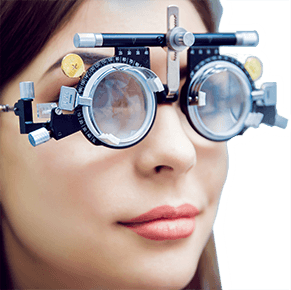Blurry vision in one eye or both eyes

What is blurry vision?
Blurry vision is the loss of sharpness of eyesight, making objects appear out of focus and hazy. The primary causes of blurred vision are refractive errors — nearsightedness, farsightedness and astigmatism — or presbyopia. Blurry vision can also be a symptom of more serious problems.
These problems may include a potentially sight-threatening eye disease or neurological disorder. Blurred vision can affect both eyes, but some people experience blurry vision in one eye only.
Cloudy vision obscures objects and causes vision to appear “milky.” It is similar to blurry vision and is sometimes indistinguishable. Cloudy vision is usually a symptom of specific conditions such as cataracts.
Blurry vision: Causes and treatment
There are several refractive errors and other minor issues that can cause blurry vision.
To determine why you have blurry vision and what is causing it, see an eye doctor for a comprehensive eye exam. Some of the more common causes of blurry vision include the following:
Myopia
Symptoms of myopia (nearsightedness) include squinting, eye strain, headaches and blurry vision in one or both eyes. Myopia is the most common refractive error and causes objects in the distance to appear blurred.
Eyeglasses and contact lenses are the most common ways to correct nearsightedness. Corneal reshaping and refractive surgery such as LASIK and PRK are also common means of correction.
Watch this video on what causes blurry vision and how we can correct it:
Hyperopia
If you have hyperopia (farsightedness), distant objects may remain clear but your eyes can’t focus properly on close-up objects. Or trying to focus causes unusual eye strain and fatigue. In cases of severe farsightedness, even distant objects may appear blurred.
Like myopia, hyperopia can be corrected with eyeglasses, contact lenses or refractive eye surgery.
Astigmatism
Blurred vision at all distances often is a symptom of astigmatism. A type of refractive error, astigmatism usually is caused by an irregularly shaped cornea.
With astigmatism, light rays fail to come to a single focus point on the retina to produce clear vision. This is true regardless of how far away the viewed object is from your eyes.
Astigmatism can also be corrected with eyeglasses, contact lenses or refractive surgery.
Presbyopia
If you’re over 40, it’s likely you are starting to notice blurry vision up close — reading a text message, a restaurant menu, food label or other small print. Chances are, this is due to the onset of presbyopia, a normal age-related vision problem.
The symptoms of presbyopia are the same as those caused by hyperopia (blurry near vision; eye strain when reading). But presbyopia is an age-related loss of ability to focus on near objects due to hardening of the lens inside the eye.
Common treatments for presbyopia include progressive lenses, bifocals and reading glasses. There also are presbyopia surgery options. These include corneal inlays, monovision LASIK and conductive keratoplasty.
Eyeglasses can be enhanced with anti-reflective coating and photochromic lenses. This helps to correct refractive errors and presbyopia, clarity and comfort. Ask your eye care professional for details.

Someone with normal vision would see crisp edges and vibrant colors in this scene.

A Jack Russell terrier, viewed by someone who has blurry vision

To someone who has cataracts, this scene could appear blurry, cloudy and/or slightly yellowed.
Chronic dry eyes
Dry eye syndrome can affect your eyes in numerous ways, including causing variable blurry vision. Artificial tears (lubricating eye drops) can help. But sometimes more advanced cases of dry eye may require a prescription medication. Your eye care professional may also recommend punctal plugs to keep your eyes comfortable, healthy and seeing well.
Pregnancy
Blurry vision may occur during pregnancy and sometimes is accompanied by double vision (diplopia). Hormonal changes can alter the shape and thickness of your cornea, causing your vision to blur. Dry eyes also are common in pregnant women and can cause blurred vision.
You should always report any vision disturbances during pregnancy to your doctor. While blurry vision is not always serious, in some cases it could be an indicator of gestational diabetes or high blood pressure.
Ocular migraines or migraine headaches
While generally harmless and temporary, blurred vision, flickering light, halos or zigzag patterns are all common symptoms prior to the start of an ocular migraine or migraine headache.
Eye floaters
Vision can be blurred by temporary spots or floaters drifting in your field of vision. Floaters typically appear when the eye’s gel-like vitreous begins to liquify with age. This causes microscopic bits of tissue within the vitreous to float freely inside the eye, casting shadows on the retina.
If you see a sudden shower of floaters, this could signal a torn or detached retina and you should see an eye doctor immediately.
Blurry vision after LASIK
Your vision may be blurry or hazy immediately after LASIK or any other type of refractive surgery. The clarity of your eyesight typically will improve within a few days, but it may take more time for your vision to stabilize completely.
Eye drops and medication
Certain eye drops can cause irritation and blurry vision when used repeatedly. This is especially true with eye drops containing preservatives.
Also, some medications such as allergy pills can cause side effects of dry eyes and blurred vision. Your optometrist or ophthalmologist can advise you whether any of your medications might cause blurry vision.
Over-wearing contact lenses
Never wear disposable contact lenses (or indeed any type of contacts) for longer than your doctor prescribes. This will cause proteins and other debris in your tear film to build up on the lenses. This can cause blurry vision and increase your risk of eye infections.
Keratoconus
Roughly one in several hundred have blurry vision in one or both eyes due to bulging of the cornea. This eye disease classically progresses during adolescence into the 20s.
Corneal cross-linking can slow or halt progressive distortion. However, vision rehabilitation generally requires specialized rigid contact lenses, including scleral lenses.
Blurry vision can be a symptom of serious eye problems
Blurry vision and cloudy vision can also both be symptoms of a serious eye problem, especially if they occur suddenly. Some of these serious eye problems may include:
Eye conditions and diseases
If you have sudden blurry vision in one eye and are over age 60, it’s possible you have developed a macular hole in the central zone of your retina.
Sudden blurry vision also may be a symptom of a detached retina, eye herpes or optic neuritis (inflammation of the optic nerve).
Certain eye conditions and diseases can cause permanent loss of vision. It’s vital to see an eye doctor for diagnosis and treatment if you experience sudden blurry vision.
Cataracts
Vision changes such as blurred vision or cloudy vision, as well as glare and halos around lights at night may be symptoms of cataracts.
If left untreated, cataracts can eventually worsen and obstruct vision to the point of blindness. Cataract surgery involves the replacement of cataracts with artificial lenses. And it is very successful in restoring lost vision.
Glaucoma
Blurry vision or "tunnel vision" may be symptoms of advanced glaucoma. Without treatment, vision loss will continue, and permanent blindness may result.
Age-related macular degeneration
Blurry vision and visual distortions causing straight lines to appear wavy or broken could be symptoms of age-related macular degeneration (AMD). AMD is a leading cause of blindness among older people.
Diabetic retinopathy
If you have diabetes, unexplained blurred vision may be due to the onset of diabetic retinopathy Diabetic retinopathy is a sight-threatening disease that damages the retina of the eye.
Cardiovascular disease and other systemic diseases
Blurred vision, often in conjunction with double vision, can be a symptom of an underlying health emergency such as a stroke or brain hemorrhage. It also can be an early sign of multiple sclerosis. If you have sudden blurry vision or double vision, see an eye doctor immediately.
SEE RELATED: Commotio Retinae
When to see an eye doctor for blurry vision
If you have mild blurry vision that comes and goes, this could mean simply tiredness, eye strain or over-exposure to sunlight.
It could also mean your vision prescription needs to be updated. Or it could mean you’ve developed a refractive error and are in need of vision correction. If your blurry vision lingers and doesn’t improve with rest, time away from screens and getting out of the sun for a while, it’s time to see an eye doctor.
Sudden or continuing changes in vision such as blurriness, double vision, tunnel vision, blind spots, halos or dimness of vision could be signs of a serious eye disease or other health problem.
If you have sudden changes to your vision, including blurry vision, you should always see an eye doctor near you immediately.
Page published on Monday, March 4, 2019
Medically reviewed on Sunday, April 25, 2021







